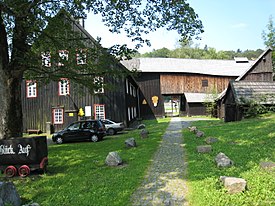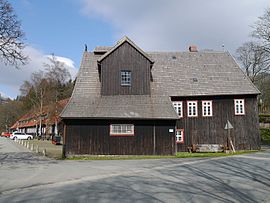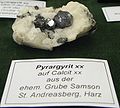Samson Pit
| Samson Pit | |||
|---|---|---|---|
| General information about the mine | |||
| West view of the Gaipel | |||
| Information about the mining company | |||
| Start of operation | circa 1521 | ||
| End of operation | March 31, 1910 | ||
| Funded raw materials | |||
| Degradation of | Silver minerals | ||
| Greatest depth | 840 m | ||
| Geographical location | |||
| Coordinates | 51 ° 42 '47 " N , 10 ° 30' 58" E | ||
|
|||
| Location | Sankt Andreasberg | ||
| local community | Braunlage | ||
| District ( NUTS3 ) | Goslar | ||
| country | State of Lower Saxony | ||
| Country | Germany | ||
| Samson Pit | |
|---|---|
|
UNESCO world heritage |
|

|
|
| Samson Pit, St. Andreasberg |
|
| National territory: |
|
| Type: | Culture |
| Criteria : | (i) (ii) (iii) (iv) |
| Reference No .: | 623 |
| UNESCO region : | Europe and North America |
| History of enrollment | |
| Enrollment: | 1992 (session 16) |
| Extension: | 2010 |
The Samson mine is a historic mine in Sankt Andreasberg in the Upper Harz Mountains .
Here you will find the last functional driving art in the world, the functions of which can be demonstrated on guided tours. The driving skills, built into the Samson pit in 1837, used to be powered by the water power of the Rehberger Graben . The starting point of the Rehberger Graben is the Oderteich , which is part of the Upper Harz water shelf . The large artificial wheel (water wheel with a diameter of 12 m), which drove the art of driving until 1922, is now only exposed to water for demonstration purposes. An electric motor drives the art of driving.
As part of the expansion of the Rammelsberg ore mine and old town of Goslar to include the facilities of the historical Upper Harz water management, the Samson mine was recognized in 2010 as part of the UNESCO world cultural heritage under the name Rammelsberg mine, Goslar old town and Upper Harz water management .
It is part of the Harz Mountains .
history
When it was in operation, the Samson Pit was one of the deepest mines in the world.
Mining in Sankt Andreasberg began before 1487. The beginning of the first operating period on Samson cannot be precisely determined due to a lack of sources, but it is dated to the early 20s of the 16th century. The first documentary mention comes from the year 1537. The oldest mining authority protocol concerning the Samson comes from the year 1661.

Mining in Sankt Andreasberg experienced its first heyday in the 1560s soon after the opening of the Samson mine. The periods with good yields were repeatedly accompanied by severe cuts up to a complete standstill of the mining industry. In particular, the construction of the New Rehberger Graben (1699–1703) to bring the water in front of it solved the regular problem of water shortage (low precipitation, frost). With a silver production of 1000 to 2000 kg per year, the Sankt Andreasberg mining experienced its second heyday in the years 1700 to 1730. On December 12, 1777, Johann Wolfgang von Goethe drove into the Samson mine as part of his first trip to the Harz Mountains and later noted in his diary: “In the evening we entered Samson, through Neufang at God's grace. Got very angry this time. "
At the beginning of the 19th century, silver production was almost always over 2000 kg per year, with the highest silver production per year being 3040 kg (1822). After the silver mining in the Samson mine deteriorated (in 1905 364 kg are extracted, in 1909 only 90 kg), it closed in 1910 for economic reasons. The last shift with 80 miners took place on March 31, 1910. The mine comprised 42 sections with a total depth of approx. 840 m.
The mine was famous as early as the 18th century for the finds of splendid and rare minerals. a. were sold through a mineral deficit in Clausthal . The silver minerals pyrargyite (dark red valid ), dyscrasite and pyrostilpnite (fire mask), the calcite crystals in various forms (paper spar, flaky spar, cannon spar, cube spar , composite spar), analcime crystals ("Andreasberger Tautropfen"), pink apophyllite , were particularly popular . Shards of cobalt (solid arsenic ), goose quack ore , Breithauptit , solid antimony , buttermilk ore and others. The very rare mineral samsonite , which was found there for the first time in 1910, was named after the pit .
In 1950, the Samson mine museum opened, now also with its own museum. On the upper floor of the museum there is now a small exhibition on the St. Andreasberg small train with historical photos, tickets, station signs and a model of the St. Andreasberg Stadt train station. In Gaipel the day building also since 2001 is the Harzer -Kanarienvogel Museum.
In 1987, the American Society of Mechanical Engineers put the Samson Mine on the list of international historical mechanical engineering monuments.
In the pit of the mine Samson are today two underground power station of the Harz Energie ( Osterode ), with which the hydropower of the pond or is converted to electrical energy. It covers most of the electrical energy required in the mountain town (around 95%). The Grüner Hirsch power plant (installed in 1922) is located at a depth of 130 m, the water of which is drained through the 1.4 km long Grünhirscher tunnel (total length 10.2 km) to the Sperrlutter . The Sieberstollen power plant was installed in 1912. It is m to a depth of 190 and is about 3.1 kilometers long Sieber tunnels (total length 13.1 kilometers) into the Sieber drained.
“Sieberstollen” power plant at a depth of 190 meters . The turbine dates back to 1912.
literature
- Jochen Klähn: Historic silver ore mine "Grube Samson" Sankt Andreasberg in the Upper Harz . Radolfzell 1985.
- Mathias Döring: The hydropower plants in Samsonschacht in St. Andreasberg / Harz , Wasserkraft und Energie 3/1996, 24–34.
- Joachim Dietrichs: 50 years of the Samson mine museum . In: St. Andreasberger Association for History and Archeology e. V. (Ed.): Contributions to the mining history of St. Andreasberg . tape 2 . St. Andreasberg 2001.
- Wilfried Ließmann : Operating history of the Samson mine . In: St. Andreasberger Association for History and Archeology e. V. (Ed.): Contributions to the mining history of St. Andreasberg . tape 2 . St. Andreasberg 2001, p. 29-78 .
Web links
Individual evidence
- ↑ Upper Harz Water Management is a World Heritage Site German UNESCO Commission e. V. August 2010, accessed November 5, 2015.
- ^ Georg Schwedt: Goethe as a chemist . Springer, Berlin 1998, ISBN 3-540-64354-0 , pp. 48 .
- ↑ Samsonit at mindat.org
- ↑ # 118 Samson Mine Reversible Waterwheel & Man Engine (1521). American Society of Mechanical Engineers, accessed March 6, 2009 .
- ↑ Samson Pit website






